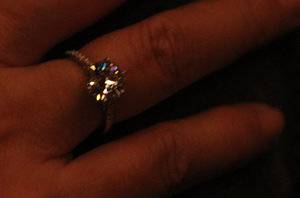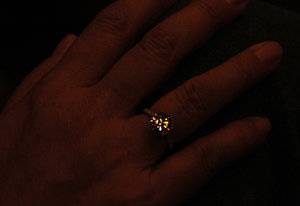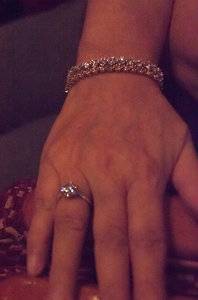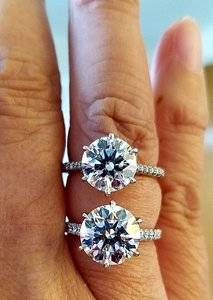- Joined
- Feb 29, 2012
- Messages
- 12,369
I posted in your other thread, Drizzle -- but I also wanted to stop by this thread to say congratulations on your beautiful new CBI. And what a treat that you got to meet Paul, John, and Wink, and view the diamond with them. Fun, fun, fun.
From my (lengthy) experience with CBI stones, the "darkness" is seen only in certain conditions. What the camera can't capture is how much full-spectrum color -- fire, rainbows, whatever you want to call it -- is displayed at the same time the stone is "dark." Even in smaller CBI stones, like whitewave's and mine, the amount of fire in a CBI is amazing. My husband and I were having dinner with another couple in a dark, spotlit restaurant. The woman, who was seated across from me, interrupted our conversation at one point to say, "I'm sorry to interrupt, I just have to say that your diamond is the sparkliest diamond I've ever seen." Note that she didn't say "Your diamond is the darkest diamond I've ever seen." It was the large flashes of color she noticed.



@Lula
Hi Lula!Thank you so much for input! It was so helpful to chat with you, a long time (and multiple) CBI owner, on this topic in person. I completely agree with you that the darkness is there only under somewhat "harsh" lighting, i.e. direct sunlight, spot lighting, under camera flash like @cflutist shared. And that's because its excessive light return causes the human pupil to adjusts down. I think of it as a "byproduct" of how well it performs in the rest of lighting situations that I love so much.
For me, the "biological phenomenon" explanation doesn't hold water especially since it's a camera and not my eye that is capturing the light. It also doesn't fit with how I understand a camera to set the exposure value for a photo based on the amount of light entering the lens. It only happens with one of the three diamonds in the video.
Even if it was your eye overcompensating it wouldn't happen instantaneously prior to you seeing a bright flash.
It's got to be something else that makes it appear dark.
this is so confusing... just when I thought I was done with the whole CBI thing I see @cflutist's video and it makes me rethink the whole thing.
this is so confusing... just when I thought I was done with the whole CBI thing I see @cflutist's video and it makes me rethink the whole thing.
To be fair to the ACA, it is precision done but compared to the CBI it is a larger table with a shallower crown, more geared towards brightness than fire, which is exactly what's evident in these videos. Get an ACA with a 55 table and a higher crown height, these differences may not be apparent.
This thread is useful to show that the different personalities based on numbers on precision cut stones is very real.
I think what you're seeing is a function of the cutting. I've owned several CBIs, with varying table sizes and crown heights, and they all have the same "look." In fact, my current CBI is closer in specs* to the ACA in these videos than it is to the specs of the CBI drizzle chose, and it exhibits that same darkness/fire phenomenon as the CBI in the videos. Drizzle saw my CBI diamond in person. We had a discussion about the darkness/fire phenomenon. It's the cut. Paul's CBIs are consistent from stone to stone because of his process.
*56.4% table; 60.9% depth; 34.1 crown angle; 40.7 pav. angle; 79% lgfs
The angles are only part of the story. Cut precision (physical symmetry, optical symmetry, etc.) is part of the story. And the cutter's "secret sauce" is no doubt a big part of it, too.
Back in the day, there used to be a lot of discussion on this forum about cut precision. It might be worth your while, if you haven't already done so, to take a look at the discussions that were happening on this forum 7 - 10 years ago about cut consistency, optical symmetry, sarin reports, physical symmetry, meet points, yaw, etc. I miss those days.
Short answer: Yes, that's exactly what I'm suggesting.Thanks for sharing your experience. I have to admit the difference in the video was quite starking, and interesting because I have not yet seen any measurable difference in cut quality based on current measures in H&A images and ASET images between the superideal vendors. Short of sarin scan reports, are you suggesting there is another secret sauce that does not appear in conventional tools that separates CBI from the competition?
.
This is a fun thread !
Wish there will be an OEC in the running next time.
I think what you're seeing is a function of the cutting. I've owned several CBIs, with varying table sizes and crown heights, and they all have the same "look." In fact, my current CBI is closer in specs* to the ACA in these videos than it is to the specs of the CBI drizzle chose, and it exhibits that same darkness/fire phenomenon as the CBI in the videos. Drizzle saw my CBI diamond in person. We had a discussion about the darkness/fire phenomenon. It's the cut. Paul's CBIs are consistent from stone to stone because of his process.
@Lula you are a wealth of knowledge! Thank you so much for sharing with us. I can definitely confirm that CBI stones have a very consistent look to them. There was another H/SI1 CBI stone in the exact same carat weight I was considering, and the two stones looked pretty much identical IRL. In the end I chose the one that had a slightly more favorable inclusion profile based on the jeweler's feedback. My jeweler also emphasized the consistency by saying how CBI is especially great for diamond studs, because you'll get a pair that looks the same.
Seeing Lula's ring IRL made me realize diamonds look even nicer when set (her stone is also a G color too I believe), which was very exciting! It was a total sparkle bomb, and super eye-catching. Even in the spotlighting where that "darkness" is most apparent, I thought her diamond in a ring exhibited a bit less of than the stone I was looking at loose.

Your rings are totally TDF!!!! I have a total ring envy...and mine is not even completedI'm currently considering a *very* delicate cushion halo for the setting, like 1mm melees around the center stone - do you think it'Il take away too much from the center stone?
OEC is the next on my wishlist... Just have to decide to go for round or cushion! haha
